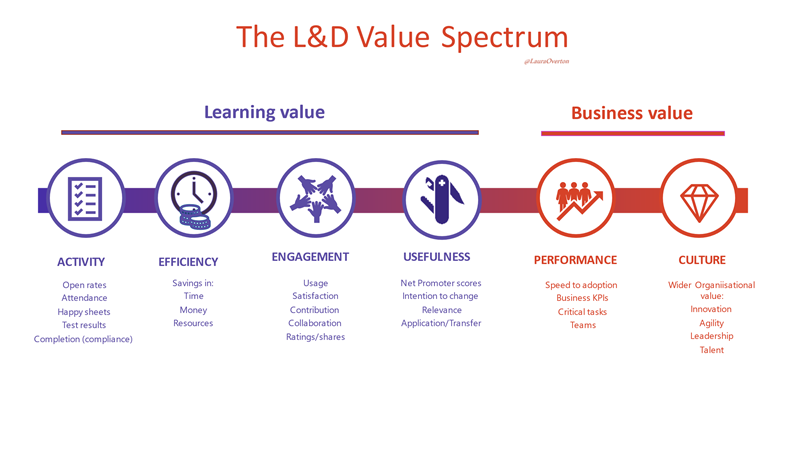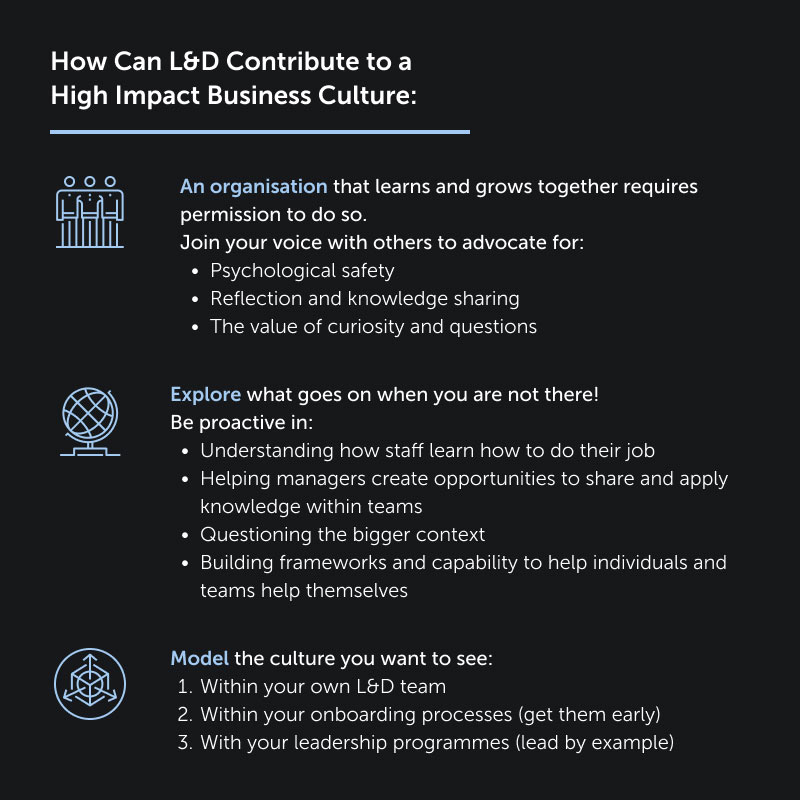How L&D can deposit into company culture
How do we get a learning culture? How can we improve it, how do we reinforce it, and how do we get people to buy into it?

If we are looking to improve learning culture – we are working on the wrong goal! Please hear me out.
The idea of learning culture has been a hot topic for several years. How do we get a learning culture? How can we improve it, how do we reinforce it, and how do we get people to buy into it? The biggest challenge I have with the learning culture concept is the idea of isolating it from company culture.
Learning culture is complicated
Siobhan Mchale, author of The Insider’s Guide to Culture Change, explains that culture differentiates one company from another. ’Think of it as an organisation’s personality’, she says, ’the set of unique attributes that give it life, make it stand out from the crowd and give it an edge over its rivals’. Culture can also be an organisation’s downfall. ‘The way we do things around here’, said Mchale, ’can make or break an organisation’.
The idea of establishing or improving a learning culture is incredibly complicated for several reasons.
Culture, of any kind, is unique to that organisation and combines all its artefacts and tradition, not just those related to learning. A company’s culture cannot be owned by a department, an individual, or a cause, and cannot be mandated by an initiative.
Learning culture is a tough concept to define. Every organisation has some form of ‘learning culture’, some just have a better one than others.
What we do know is that learning culture is the way an organisation provides permission to share knowledge and experience, to learn from failure, and to develop and adapt. It also makes a difference to the way that they operate, grow, and adapt.1
How do you define learning culture?
I have a hypothesis about how L&D professionals define learning culture. Our definition and expectations of learning culture are influenced by how we perceive the value we can add to the business.
At the end of 2020, Valamis Account Director and Consultant, Tom Ridley and I took part in a webinar programme, How to Build a Smarter Business Case for L&D.2 We explored the L&D Value Spectrum – a simple model for how L&D track the value that they add back to their organisation.

As learning professionals we see ourselves supporting the business by solving learning problems. We can track our success by how efficiently we produce solutions to challenges, and how actively engaged the organisation and individuals are with our solutions.
Creating learning value is not a bad thing! We will provide more opportunities for individuals to access new knowledge and ideas – anytime, anyplace, and anywhere. We are also likely to work on great learning design and experiences. All of which will provide more openings for individuals to take control and own their development journeys.
My hypothesis is that those at the learning value end of the spectrum are likely to be operating a transactional model of L&D and responding to demand within the organisation. They are likely to define a good learning culture by how an organisation places high value on the process and theory of learning, that celebrates and encourages self-directed learning and invests heavily in the tools and processes to encourage learning.
I would suggest those operating at the learning value end would also face common frustrations with learning culture: lack of engagement and buy in, exasperation with individuals and managers, and in some cases, feeling that we always must prove our worth. All of which would be improved if only the organisation learning culture was better!
Alternatively, learning professionals operating at the business end of the spectrum will define their value in the way they contribute their expertise to solving business challenges.
Learning professionals’ contribution is not just about producing learning interventions but finding ways to help organisations, teams and individuals adapt, flex, and learn – even when they are not in the ‘room’!
High performing learning organisations have L&D leaders who are twice as likely to be tracking business performance indicators and consistently analysing the business problem before recommending any kind of solution.3
They are six times more likely to report improvements in business agility and culture because of their work. My hypothesis is that these organisations will define learning culture by the ability of the organisation to innovate, share, solve problems and mitigate risk. They will define learning culture without using the word learning.
We are all the CEO of culture
I heard my favourite quote about culture in a podcast of Learning Uncut, back in 2019.4 Beth Hall of Cotton on Group shared the powerful emphasis they place on every individual as an influencer of culture. Hall explained that ‘every behaviour and every interaction, everything that you do on a daily basis, either deposits into our culture bank account, or it takes its toll’. This global Australian retail group considers everybody to be the CEO of culture because everyone owns the culture.
So as CEOs of culture, how are we as individual L&D professionals influencing the culture of our own organisations?
We all aspire to work in an organisation that shares freely, adapts rapidly, values the process of learning, unlearning and letting go, and that proactively explores new ways of doing things smarter.
So, to what extent are we living, breathing, and modelling those behaviours in our own individual lives? Are we depositing into this company culture bank account or withdrawing from it?
This means going beyond creating great opportunities for everyone to access programmes. It goes beyond directors supporting investment, managers giving permission or even empowering individuals to access programmes.
How can L&D proactively influence the business culture?
L&D leaders in high impact learning organisations are more likely to support learning in the flow of work, create opportunities to enable performance at the point of need and, where appropriate, know when to get out of the way.
They will be as likely to work on long term campaigns to build habits as they are on producing accessible content.
The picture highlights some of the tactics that I have seen in high performing organisations – you may have your own, please share!

For me, a high performing learning culture is one where individuals, leaders, teams, and L&D departments are all working together to share, grow and adapt for the benefit of the business. You don’t have to use the word learning to have a learning culture.
How can we as individual L&D leaders influence our organisation’s culture for good?
By personally depositing into the culture that we want to see. Everyday. In everything that we do and everything that we say. One step at a time!
Sources
1. Bersin, J. 2010. How to Build a High-Impact Learning Culture. Article. Published on June 10, 2010.
Emerald Works &Towards Maturity. 2016. Unlocking potential: Releasing the potential of the business and its people through learning. Report. Published in November, 2016.
Daly, J. & Overton, L. 2017. Driving the new learning organisation: the potential of L&D. Towards Maturity & CIPD. Published on May 4, 2017.
2. Valamis. 2020. Making a Smarter Business Case for L&D. Webinar. Broadcasted on November 24, 2020.
3. Emerald Works & Towards Maturity. The Transformation Journey. Today’s learning strategy for tomorrow’s business success. Report. Published in February, 2019.
4. Learning Uncut. Enabling performance through deliberately different L&D. Podcast. Broadcasted on August 19, 2019.

Build a learning culture: a practical workbook for your organization
Upgrade your organization’s learning culture with clear, actionable strategies to address the challenges.
Download workbook



